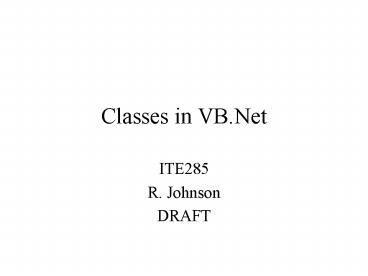Classes in VB'Net - PowerPoint PPT Presentation
1 / 12
Title:
Classes in VB'Net
Description:
Objects tightly 'bundle' data & related functions (methods) as members. This is Encapsulation. Class is the custom data type from which an instance, an object, is ... – PowerPoint PPT presentation
Number of Views:46
Avg rating:3.0/5.0
Title: Classes in VB'Net
1
Classes in VB.Net
- ITE285
- R. Johnson
- DRAFT
2
Classes in Java
- Objects tightly bundle data related
functions (methods) as members - This is Encapsulation
- Class is the custom data type from which an
instance, an object, is declared. - Inheritance Polymorphism also in VB.NET
3
Parts of An Object in Java
- Data members (private)
- Sets and gets (called explicitly)
- Methods
- Constructor default and overloaded
- Destructor
4
Parts of An Object in VB.NET
- Data members (private)
- Properties (easier sets and gets)
- Methods
- Constructor default and overloaded
- Destructor (when dynamic memory allocated)
5
Property Procedures
- A property is a wrapper around a private data
member. - Incorporates sets and gets.
- Feels like accessing a public data member.
- Right side of ? automatically calls get
- Left side of ? automatically calls set
6
Three Ways to Approach Objects
- Classes strengthen separation of Non-Interface
code - Think of objects as smart data in collection
- Interface code --- properties for custom dialogs
7
A Simple Class EPAtestCar
- Model
- Miles
- Gallons Gas Used
- Low Emissions Vehicle?
- Method CalcMPG
8
Additions to EPAtestCar
- Property Procedures (streamlined sets gets)
- Default Overloaded Constructors (New)
- Override inherited ToString method
- CompareTo method and interface IComparable (lets
Array.Sort() work) - Throwing exceptions from inside a class to be
caught elsewhere. From property sets?
9
A Common Class Design Pitfall
- Normally do NOT create data members which store
the results of calls to the classs methods. - Only store essential, independent data as data
members. - Derived or dependent data should be obtained by
calling the method(s) which compute it, as
needed. - Example a class Rectangle with properties for
length and a method to calculate the area
10
Bad Practice!
- Dim r As Rectangle has an area data member
- r.length 4 set properties
- r.width 2
- r.calcArea() call subroutine method
- that only stores
result internally - Messagebox.show (r.area) access property
- storing the
result of 8
11
Why is this Bad?
- Dim r As Rectangle has an area data member
- r.length 4 set properties
- r.width 2
- r.calcArea() call subroutine method,
stores area - r.Length 5 change length!!!
- object now inconsistent, stored area is invalid
now! - Messagebox.show (r.area) has 8, should be 10!
12
Good Practice
- Dim r As Rectangleno data member for area!
- r.length 4 set properties
- r.width 2
- call function method that returns a freshly
- computed value as needed
- Messagebox.show (r.calcArea())
- Alternative this could instead be a ReadOnly
property whose Get does the calculation whenever
referenced































